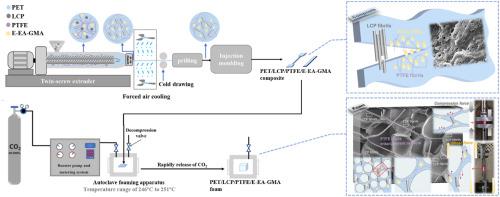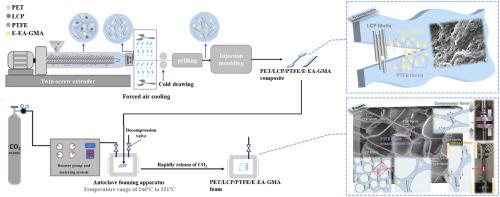高刚度高延性PET复合泡沫:E-EA-GMA与LCP/PTFE同步原位颤动的协同效应
IF 4.5
2区 化学
Q2 POLYMER SCIENCE
引用次数: 0
摘要
在聚对苯二甲酸乙二醇酯(PET)基体中,同时原位形成椭圆型乙烯-丙烯酸乙酯-甲基丙烯酸缩水甘油酯(E-EA-GMA)、液晶聚合物(LCP)原纤维和聚四氟乙烯(PTFE)原纤维,使PET复合材料具有高刚性和高韧性。当E-EA-GMA含量为10 wt%时,复合材料的冲击强度增加了10倍,同时保持了刚性。E-EA-GMA可显著提高材料的韧性,而LCP/PTFE纤维可有效保持材料的刚性。该PET复合材料进一步加工成密度为240 kg/m3(高密度)、150 kg/m3(中密度)和100 kg/m3(低密度)的PET泡沫。降低泡沫密度可以提高延展性,断裂时增加的剪切伸长率就是明证。更重要的是,增强的基体韧性与改善的泡沫延展性密切相关,特别是在高密度泡沫中,这种相关性变得更加明显。在PET泡沫结构中,E-EA-GMA组分吸收能量并发生塑性变形,显著增加断裂时的剪切伸长率。同时,刚性棒状LCP纤维和柔性聚四氟乙烯纤维缠绕在一起,分散在泡沫胞壁内,在外部载荷下提供结构支撑,有效地保持刚度。这种协同作用可以同时提高材料的刚度和延性,抗剪强度提高136%,抗压强度提高39%,抗压模量提高66%。虽然降低泡沫密度通常会以牺牲刚度为代价来提高延展性,但E-EA-GMA与LCP/PTFE原位纤颤的协同使用成功地克服了这种权衡,实现了具有高延展性和高刚度的PET泡沫。本文章由计算机程序翻译,如有差异,请以英文原文为准。


PET composite foam with high stiffness and high ductility: Synergistic effect of Toughener combined with simultaneous in-situ fibrillation of LCP/PTFE
In polyethylene terephthalate (PET) matrix, the simultaneous in situ formation of elliptical ethylene–ethyl acrylate–glycidyl methacrylate (E-EA-GMA), liquid crystalline polymer (LCP) fibrils, and polytetrafluoroethylene (PTFE) fibrils enables the fabrication of PET composites with both high rigidity and high toughness. At an E-EA-GMA content of 10 wt%, the composite exhibits a tenfold increase in impact strength while maintaining rigidity. E–EA–GMA significantly promotes toughness, while LCP/PTFE fibrils effectively maintain rigidity.
This PET composite is further processed into PET foams with densities of 240 kg/m3 (high density), 150 kg/m3 (medium density), and 100 kg/m3 (low density). Reducing foam density improves ductility, as evidenced by increased shear elongation at break. More importantly, the enhanced matrix toughness is closely linked to improved foam ductility, particularly in high-density foams, where this correlation becomes more pronounced. Within the PET foam structure, the E-EA-GMA component absorbs energy and undergoes plastic deformation, significantly increasing shear elongation at break. Meanwhile, the rigid rod-like LCP fibrils and flexible PTFE fibrils entangled networks, dispersed within the foam cell walls, provide structural support under external loads, effectively maintaining stiffness. This synergy results in simultaneous improvements in both stiffness and ductility, as evidenced by a 136 % increase in shear strength, a 39 % increase in compressive strength, and a 66 % increase in compressive modulus.
Although reducing foam density typically improves ductility at the expense of stiffness, the synergistic use of E-EA-GMA with in-situ fibrillation of LCP/PTFE successfully overcomes this trade-off, achieving PET foams with both high ductility and high stiffness.
求助全文
通过发布文献求助,成功后即可免费获取论文全文。
去求助
来源期刊

Polymer
化学-高分子科学
CiteScore
7.90
自引率
8.70%
发文量
959
审稿时长
32 days
期刊介绍:
Polymer is an interdisciplinary journal dedicated to publishing innovative and significant advances in Polymer Physics, Chemistry and Technology. We welcome submissions on polymer hybrids, nanocomposites, characterisation and self-assembly. Polymer also publishes work on the technological application of polymers in energy and optoelectronics.
The main scope is covered but not limited to the following core areas:
Polymer Materials
Nanocomposites and hybrid nanomaterials
Polymer blends, films, fibres, networks and porous materials
Physical Characterization
Characterisation, modelling and simulation* of molecular and materials properties in bulk, solution, and thin films
Polymer Engineering
Advanced multiscale processing methods
Polymer Synthesis, Modification and Self-assembly
Including designer polymer architectures, mechanisms and kinetics, and supramolecular polymerization
Technological Applications
Polymers for energy generation and storage
Polymer membranes for separation technology
Polymers for opto- and microelectronics.
 求助内容:
求助内容: 应助结果提醒方式:
应助结果提醒方式:


